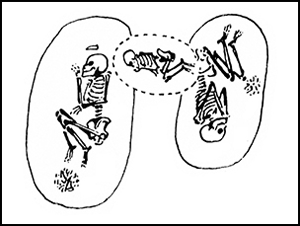Crossref Citations
This article has been cited by the following publications. This list is generated based on data provided by
Crossref.
Ensor, Bradley E.
2021.
Making aDNA useful for kinship analysis.
Antiquity,
Vol. 95,
Issue. 379,
p.
241.
Frieman, Catherine J.
2021.
Emergent or imposed?.
Antiquity,
Vol. 95,
Issue. 379,
p.
247.
Žegarac, A.
Winkelbach, L.
Blöcher, J.
Diekmann, Y.
Krečković Gavrilović, M.
Porčić, M.
Stojković, B.
Milašinović, L.
Schreiber, M.
Wegmann, D.
Veeramah, K. R.
Stefanović, S.
and
Burger, J.
2021.
Ancient genomes provide insights into family structure and the heredity of social status in the early Bronze Age of southeastern Europe.
Scientific Reports,
Vol. 11,
Issue. 1,
Brück, Joanna
2021.
Kinship: politics and practice.
Antiquity,
Vol. 95,
Issue. 379,
p.
249.
Soriano, I.
Herrero-Corral, A.M.
Garrido-Pena, R.
and
Majó, T.
2021.
Sex/gender system and social hierarchization in Bell Beaker burials from Iberia.
Journal of Anthropological Archaeology,
Vol. 64,
Issue. ,
p.
101335.
Furholt, Martin
2021.
Exploring human possibilities.
Antiquity,
Vol. 95,
Issue. 379,
p.
244.
Crellin, Rachel J.
2021.
Making posthumanist kin in the past.
Antiquity,
Vol. 95,
Issue. 379,
p.
238.
Laing, Meredith
2022.
YOUNG HANDS AT WORK. USING FINGER IMPRESSIONS TO EXPLORE THE DEMOGRAPHIC CONSTITUTION OF EARLY AND MIDDLE BRONZE AGE POTTERY‐MAKING COMMUNITIES OF PRACTICE.
Oxford Journal of Archaeology,
Vol. 41,
Issue. 4,
p.
350.
Bentley, R. Alexander
2022.
Prehistory of Kinship.
Annual Review of Anthropology,
Vol. 51,
Issue. 1,
p.
137.
Fowler, Chris
Olalde, Iñigo
Cummings, Vicki
Armit, Ian
Büster, Lindsey
Cuthbert, Sarah
Rohland, Nadin
Cheronet, Olivia
Pinhasi, Ron
and
Reich, David
2022.
A high-resolution picture of kinship practices in an Early Neolithic tomb.
Nature,
Vol. 601,
Issue. 7894,
p.
584.
BLOXAM, ANNA
and
PARKER PEARSON, MIKE
2022.
Funerary Diversity and Cultural Continuity: The British Beaker Phenomenon Beyond the Stereotype.
Proceedings of the Prehistoric Society,
Vol. 88,
Issue. ,
p.
261.
Brück, Joanna
and
Booth, Thomas J.
2022.
The Power of Relics: The Curation of Human Bone in British Bronze Age Burials.
European Journal of Archaeology,
Vol. 25,
Issue. 4,
p.
440.
Cintas-Peña, Marta
and
García Sanjuán, Leonardo
2022.
Women, residential patterns and early social complexity. From theory to practice in Copper Age Iberia.
Journal of Anthropological Archaeology,
Vol. 67,
Issue. ,
p.
101422.
Fowler, Chris
2022.
Social arrangements. Kinship, descent and affinity in the mortuary architecture of Early Neolithic Britain and Ireland.
Archaeological Dialogues,
Vol. 29,
Issue. 1,
p.
67.
Carlin, Neil
2022.
A grave matter of ancient kinship in Neolithic Britain.
Nature,
Vol. 601,
Issue. 7894,
p.
510.
Moore, Hazel
Wilson, Graeme
Ni Challanain, Mairead
McCormick, Maeve
Marshall, Peter D.
Dulias, Katharina
Foody, M. George B.
Justeau, Pierre
Pala, Maria
Richards, Martin B.
and
Edwards, Ceiridwen J.
2022.
Migration and community in Bronze Age Orkney: innovation and continuity at the Links of Noltland.
Antiquity,
Vol. 96,
Issue. 387,
p.
541.
Frieman, Catherine J.
2023.
Archaeology as History.
Cvrček, Jan
Drtikolová Kaupová, Sylva
Vytlačil, Zdeněk
Zazvonilová, Eliška
and
Velemínský, Petr
2023.
When DNA can't help: The osteobiographical profile and stable isotope analysis as auxiliary tools for refining genealogical relationships, on the example of the Swéerts‐Sporck family.
Archaeometry,
Vol. 65,
Issue. 6,
p.
1336.
Harney, Éadaoin
Micheletti, Steven
Bruwelheide, Karin S.
Freyman, William A.
Bryc, Katarzyna
Akbari, Ali
Jewett, Ethan
Comer, Elizabeth
Gates, Henry Louis
Heywood, Linda
Thornton, John
Curry, Roslyn
Esselmann, Samantha Ancona
Barca, Kathryn G.
Sedig, Jakob
Sirak, Kendra
Olalde, Iñigo
Adamski, Nicole
Bernardos, Rebecca
Broomandkhoshbacht, Nasreen
Ferry, Matthew
Qiu, Lijun
Stewardson, Kristin
Workman, J. Noah
Zalzala, Fatma
Mallick, Shop
Micco, Adam
Mah, Matthew
Zhang, Zhao
Rohland, Nadin
Mountain, Joanna L.
Owsley, Douglas W.
Reich, David
Aslibekyan, Stella
Auton, Adam
Babalola, Elizabeth
Bell, Robert K.
Bielenberg, Jessica
Bullis, Emily
Coker, Daniella
Cuellar Partida, Gabriel
Dhamija, Devika
Das, Sayantan
Elson, Sarah L.
Filshtein, Teresa
Fletez-Brant, Kipper
Fontanillas, Pierre
Heilbron, Karl
Hicks, Barry
Hinds, David A.
Jiang, Yunxuan
Kukar, Katelyn
Lin, Keng-Han
Lowe, Maya
McCreight, Jey
McIntyre, Matthew H.
Moreno, Meghan E.
Nandakumar, Priyanka
Noblin, Elizabeth S.
O’Connell, Jared
Petrakovitz, Aaron A.
Poznik, G. David
Schumacher, Morgan
Shastri, Anjali J.
Shelton, Janie F.
Shi, Jingchunzi
Shringarpure, Suyash
Tran, Vinh
Tung, Joyce Y.
Wang, Xin
Wang, Wei
Weldon, Catherine H.
Wilton, Peter
Hernandez, Alejandro
Wong, Corinna D.
Tchakouté, Christophe Toukam
Fitch, Alison
Reynoso, Alexandra
Granka, Julie M.
Su, Qiaojuan Jane
Kwong, Alan
Eriksson, Nicholas
Nguyen, Dominique T.
Llamas, Bianca A.
and
Tat, Susana A.
2023.
The genetic legacy of African Americans from Catoctin Furnace.
Science,
Vol. 381,
Issue. 6657,
Armit, Ian
Fischer, Claire-Elise
Koon, Hannah
Nicholls, Rebecca
Olalde, Iñigo
Rohland, Nadin
Buckberry, Jo
Montgomery, Janet
Mason, Philip
Črešnar, Matija
Büster, Lindsey
and
Reich, David
2023.
Kinship practices in Early Iron Age South-east Europe: genetic and isotopic analysis of burials from the Dolge njive barrow cemetery, Dolenjska, Slovenia.
Antiquity,
Vol. 97,
Issue. 392,
p.
403.



